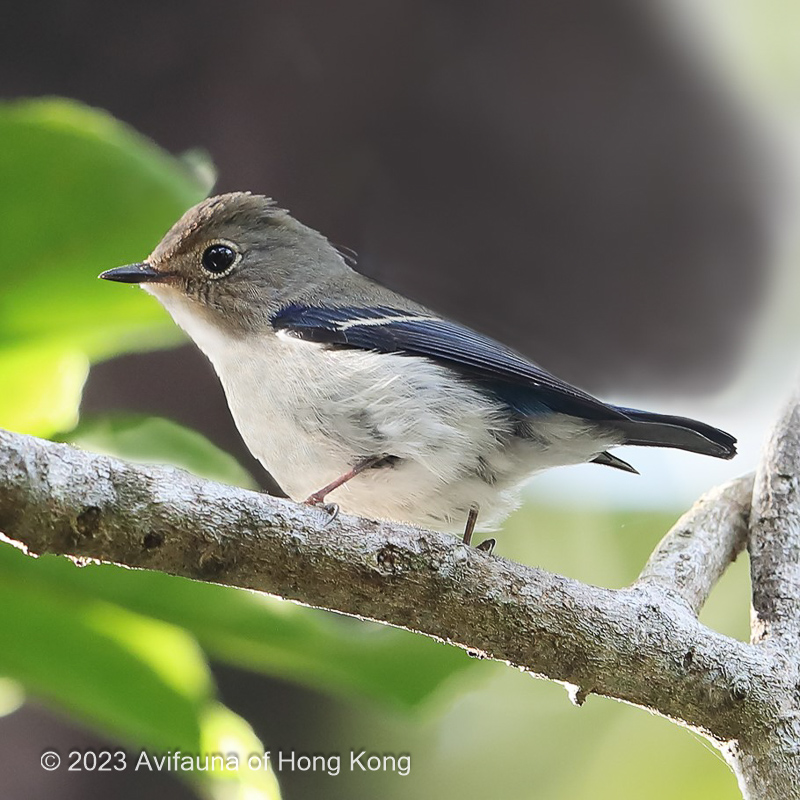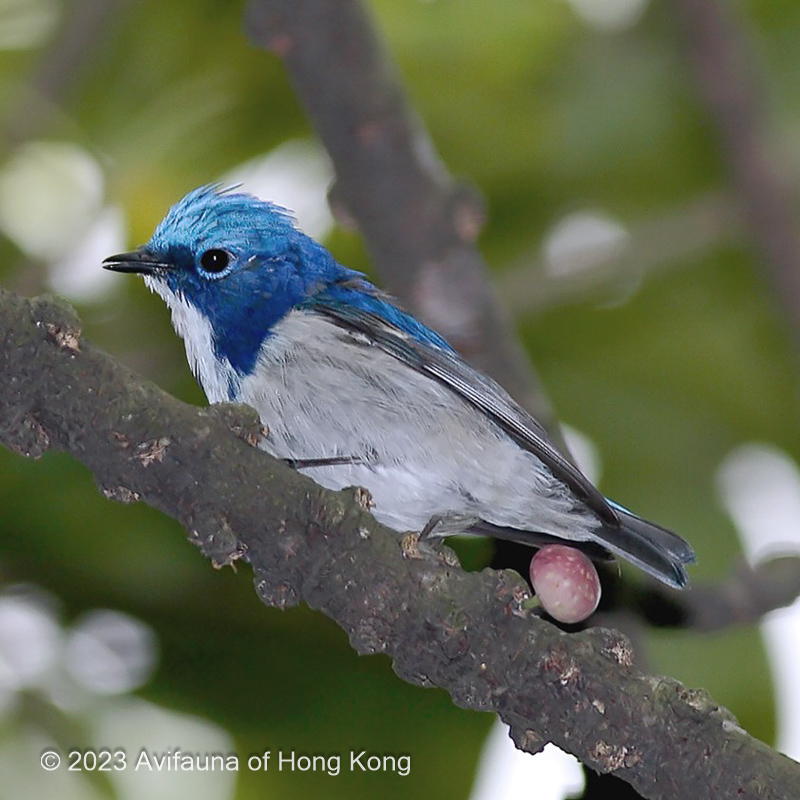Ultramarine Flycatcher Ficedula superciliaris 白眉藍姬鶲
Category I. Accidental.
IDENTIFICATION

Nov. 2017, Michelle and Peter Wong. First-winter male.
11-12cm. First-winter male has grey-brown upperparts, pale underparts and blue wings, rump and tail. It has a white greater covert wing bar, conspicuous white fringes to the tertials and a pale eye ring.
The female (not recorded in HK) has greyish-brown upperparts and white underparts apart from greyish breast sides that mirror those of the adult male. Sometimes the grey extends across the whole breast and there is a bluish tinge on the uppertail-coverts and tail.

Apr. 2007, Michelle and Peter Wong. Adult male.
The adult male has deep blue upperparts and blue lateral breast patches; the underparts are white. The photo shows a second calendar-year male moulting into adult-like plumage. The crown is paler than on the adult male, but the blue breast patches and the white underparts are obvious.
VOCALISATIONS
Vocalisations include a moderately high-pitched ‘tsee’ and a short rattle.
DISTRIBUTION & HABITAT PREFERENCE
All records have occurred in woodland on the Tai Mo Shan massif, either at Kadoorie Farm and Botanic Garden (KFBG) or Shek Kong catchwater.
OCCURRENCE
1999: a first-winter male at KFBG during 16-17 January.
2006: a first-winter male at KFBG on 28 December.
2007: a second calendar-year male at KFBG during 5-7 April is assumed to be the same bird as recorded in December 2006.
2017: a first-winter male at Shek Kong catchwater from 29 November to 11 December.
2018: a first-winter male at Shek Kong catchwater on 31 January 2018 is believed to be the same birds as was present there in 2017. Another first-winter male was seen at Shek Kong catchwater on 28th and 30 December.
The first two records of Ultramarine Flycatcher were initially placed in Category III due to the possibility of non-natural occurrence. These were reassessed after the record in 2017 and the species was placed in Category I (Allcock 2019).
BEHAVIOUR, FORAGING & DIET
Typical flycatching behaviour.
RANGE & SYSTEMATICS
Ultramarine Flycatcher breeds above 1,800 m from eastern Afghanistan through the central Himalayas east to northeast India and southwest China; it winters to lower altitudes locally and further south from central India east to Myanmar, northwest Thailand and southwest China. F. s. aestigma occurs in China and breeds from southeast Tibet east to southwest Sichuan and north Yunnan; some winter in south Yunnan (Clement and de Juana 2020).
CONSERVATION STATUS
IUCN: Least Concern. Population trend stable.
Allcock, J. A. (2019). Ultramarine Flycatcher Ficedula superciliaris along Shek Kong Catchwater, near Lui Kung Tin. The first Hong Kong record accepted to Category I. Hong Kong Bird Report 2017: 270–273.
Clement, P. and E. de Juana (2020). Ultramarine Flycatcher (Ficedula superciliaris), version 1.0. In Birds of the World (J. del Hoyo, A. Elliott, J. Sargatal, D. A. Christie, and E. de Juana, Editors). Cornell Lab of Ornithology, Ithaca, NY, USA. https://doi.org/10.2173/bow.ultfly1.01

